Be Aware › Raccoons

Raccoons, or Procyon lotor, are found throughout the United States, but are not native to Utah. They live in forests, marshes, near lakes and rivers and even in urban areas.
Raccoons are gray in color, with bushy, black, ringed tails and black masks across their faces. Tracks are about 4½ inches long. The hind print is longer that the front print and five toes can be clearly visible in the tracks of both feet.
Adults may weigh 10–30 lbs. Vocalizations include high-pitched squeals and chatter. Their scientific name means “washer” because they sometimes dunk their food in water before eating it.
Raccoons are mainly active at night and are solitary, except when raising young. The breeding season usually occurs from January to March. Typically three to five young are born in April or May. The young will disperse later in the fall.
Raccoons are opportunist omnivores. They eat plants, fish, insects, small mammals, reptiles, birds and eggs. In urban areas, they may seek out pet food, gardens and trash.
Legal status
Raccoons are not protected in Utah. No hunting or trapping license is required to take them. Utah state law prohibits possessing a live raccoon without a permit.
Avoiding Conflicts
Human/raccoon conflicts can occur in urban areas throughout the state. Raccoons will prey on poultry and small pets, and may try to get into trash and gardens. They have also been known to nest in attics, chimneys, basements and garages. They can enter through holes already present in a structure, or they can dig and rip an opening.
Raccoons in a home can sometimes be heard scurrying about, whining or growling. Raccoons can pose a risk to humans and pets with some of the diseases they carry, such as distemper, mange, rabies, and canine and feline parovirus and roundworm.
- Do not approach or try to feed raccoons.
- Vaccinate your pets.
- Always observe raccoons from a safe distance.
Raccoon Vocalization
Tracks
The five long rear toes and the “hand-like” front print are characteristic of raccoon tracks. Tracks are approx. 2–4½ inches long.
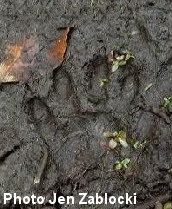

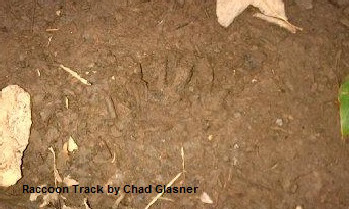
Scat
Usually tubular and contains whatever they have recently eaten (e.g., berries, seeds, feathers, fur).



Examples of Damage




Raccoons have been known to inhabit chimneys, attics, basements and garages. They can enter through holes already present or create their own entry hole.
Determining that raccoons are responsible for the damage is the first step; removing attractants and exclusion are the next steps in avoiding conflicts. Involving neighbors in these efforts is the key to success.
Exclusion and Deterrents

Install chimney caps to prevent raccoons from nesting. Fall is the best time to install the caps, since the raccoons are not raising young. If you discover raccoons have moved into your uncovered chimney, it is best to wait for them to move out on their own. After eight to ten weeks, the mother and young will leave and not return.
While covering holes and decks, be sure to avoid sealing animals inside. Sprinkle flour around the area. If you do not find tracks for several days, it is okay to proceed.
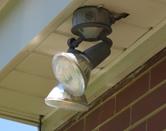
Cover attic exhaust pipes with hardware cloth to block entry points. To deter raccoons from your property, install motion sensor lighting, and if possible use in conjunction with noise makers, such as a radio. Trim back overhanging tree limbs and tack 3-foot square sheets of slick metal on the corners of buildings. Doing so will prevent raccoons from climbing onto the building.

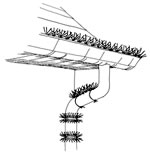



Open window wells can easily trap wildlife. To prevent wildlife from falling into window wells, cover them with a grate. Commercially available metal or plastic spikes can help keep raccoons off of buildings.
Prevent raccoons from entering your home in search of food by locking pet doors at night. You can also fence off gardens or ponds to keep raccoons out. Keep bushes trimmed back and woodpiles stacked neatly.
A raccoon guard can be secured around trees, pipes, posts, and other structures to keep raccoons from climbing. The guard can be made from a piece of aluminum flashing or sheet metal, held together with wire, nails, or screws, and painted to blend in.1
Repellents
There are no toxicants or repellents that have proven useful for raccoon control.
Fencing
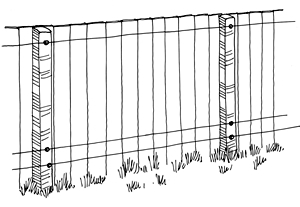
Use woven wire fencing, with electric wires at the top and bottom, around hobby poultry yards and gardens. Raccoons can easily climb wood or wire fences, or bypass them by using overhanging limbs of trees or shrubs. Wire fences will need to have a mesh size that is no wider than 3 inches to keep young raccoons out.
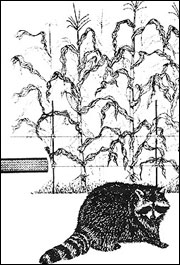
Install two electrified wires, 12 and 18 inches above ground and onto existing fence posts, poultry pen supports, and other structures, using the proper insulators. Adding an electrified wire to the top of the fence will prevent raccoons from climbing over.1
A “ribbon” electric fence may also be effective. Use woven wire fencing around poultry yards and gardens. Approximately 8 inches should be buried in the ground to prevent a raccoon from digging under.
Adding a two-wire electric fence will help keep raccoons out of field or garden crops. This inset shows the “ribbon-type” electric fence in place of the single-wire type. This ribbon fence is more visible to raccoons and other wildlife and may improve control.2
Remove attractants
Trash should be kept indoors at night and put out the morning of pick-up. If this cannot be done, trash cans should be secured to avoid being overturned and the lids should be weighed or locked. After market cables and locking devices can be purchased to secure trash cans and dumpsters.
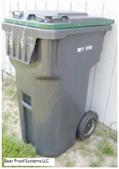

Visit: www.raccoonsolutions.com
- If a raccoon becomes trapped inside a garbage can or dumpster, place a sturdy branch in the dumpster to allow the raccoon to climb out on its own.
- Do not leave pet food or water bowls outside.
- Keep pets, especially housecats, as well as poultry, rabbits and other hobby livestock secured in a building or barn at night.
Raccoon on your porch or in your yard
If you find a raccoon on your porch or in your yard, use noise makers to scare it away. Use a hose or water gun to deter the raccoon from approaching. Keep a good distance from the animal and do not corner it.
Raccoon inside your home
If a raccoon gets into your home, close off access to other areas of the home. Open all doors and windows, then go outside and watch for the raccoon to leave. Do not use food as bait. If the raccoon still won’t leave, contact a professional pest control company. Do not attempt to remove the animal yourself.
If you have problems with raccoons that cannot be resolved by following these tips, please consult a professional, licensed animal control company.
References
- Washington Dept. of Fish and Wildlife
- Information from USU Cooperative Extension USDA Wildlife Damage and Management Series and Internet Center for Wildlife Damage Management (ICWDM) and Washington Dept. of Fish and Wildlife Adapted from “Living with Wildlife in the Pacific Northwest.” Written by: Russell Link, WDFW Urban Wildlife Biologist.

